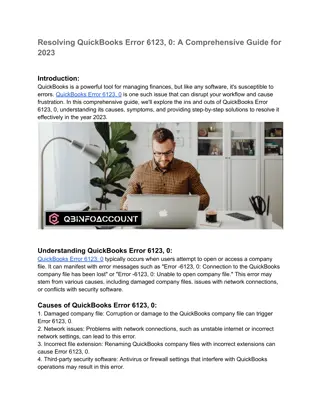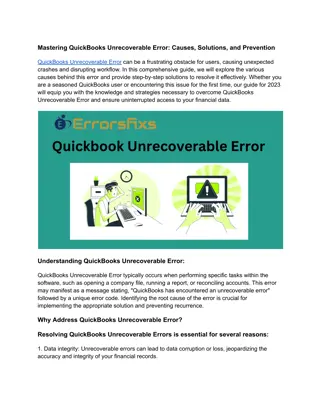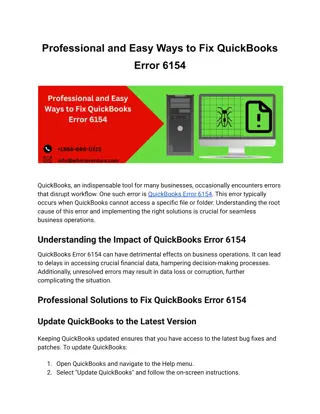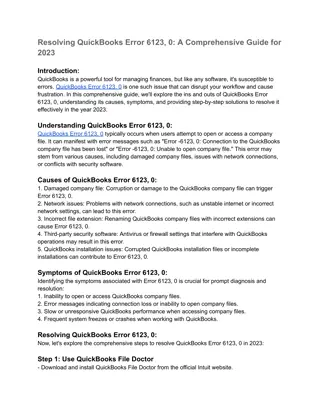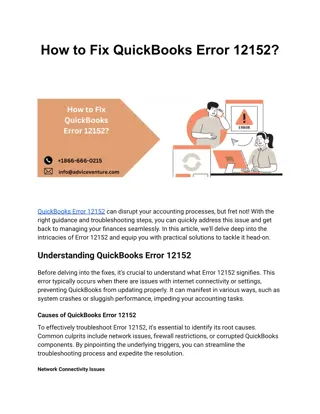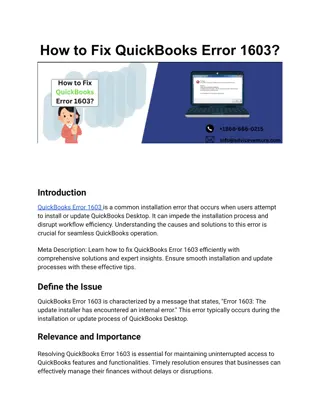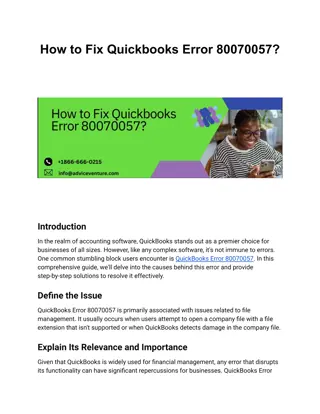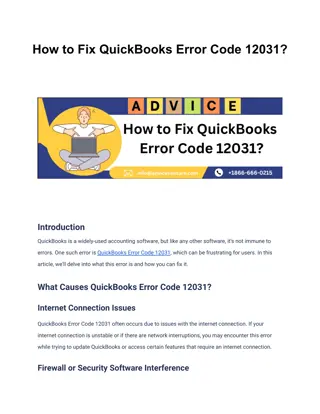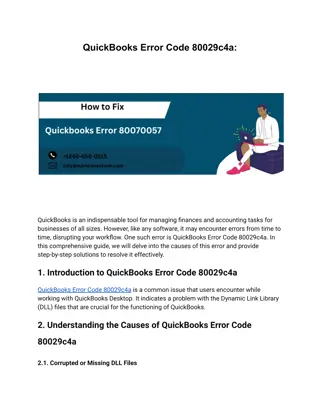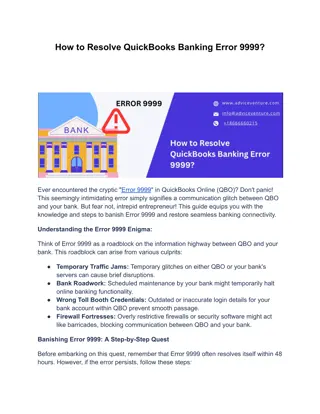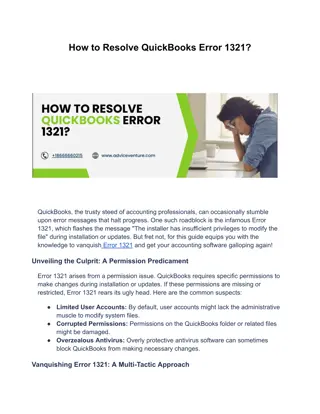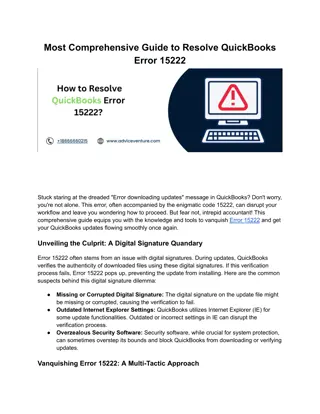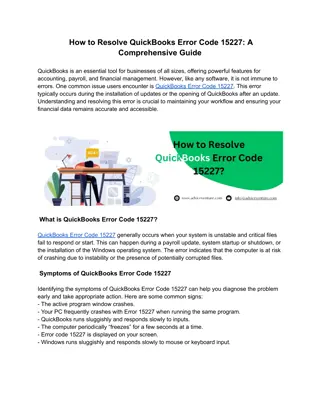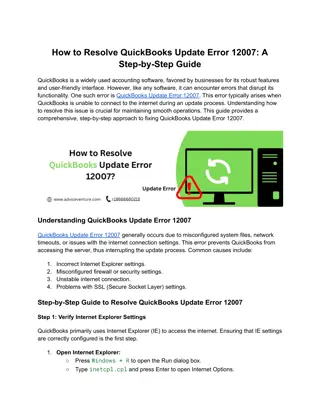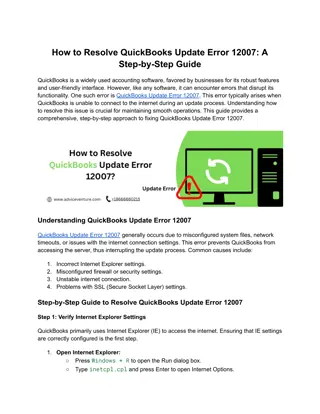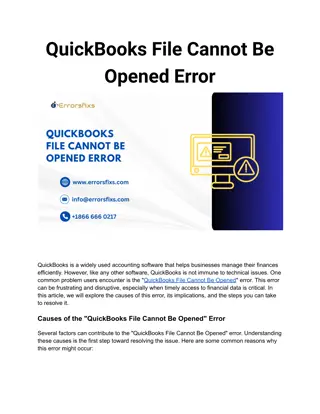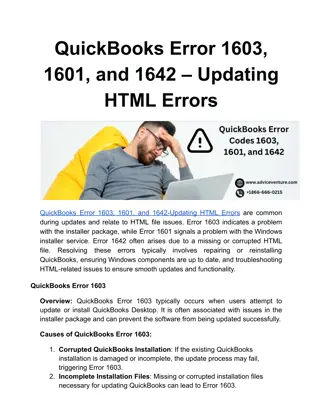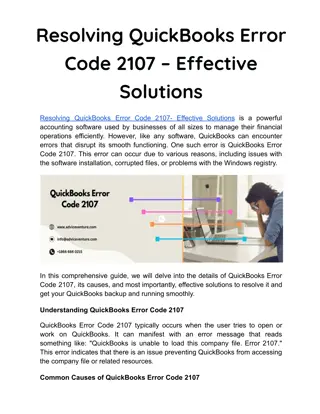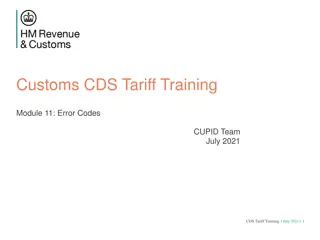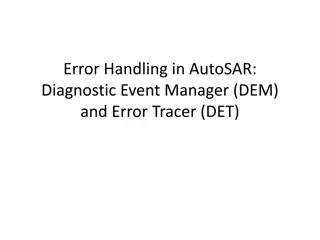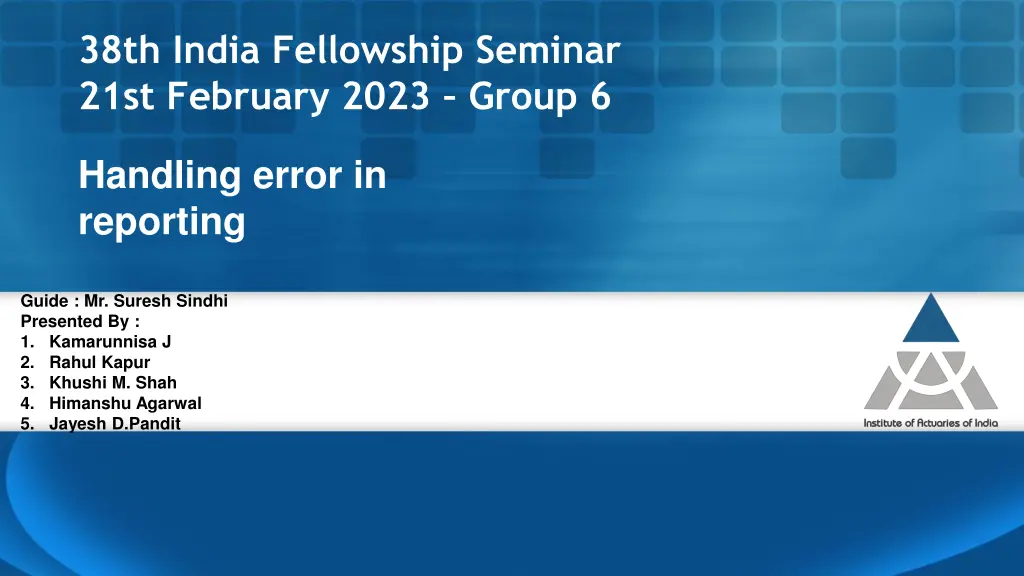
Handling Errors in Pension Work: Insights and Solutions
Explore the challenges and solutions in handling errors in pension work, focusing on financial and demographic assumptions, accounting standards, scheme benefits, modeling, and data discrepancies. Learn professional approaches to address errors effectively and communicate with stakeholders.
Download Presentation

Please find below an Image/Link to download the presentation.
The content on the website is provided AS IS for your information and personal use only. It may not be sold, licensed, or shared on other websites without obtaining consent from the author. If you encounter any issues during the download, it is possible that the publisher has removed the file from their server.
You are allowed to download the files provided on this website for personal or commercial use, subject to the condition that they are used lawfully. All files are the property of their respective owners.
The content on the website is provided AS IS for your information and personal use only. It may not be sold, licensed, or shared on other websites without obtaining consent from the author.
E N D
Presentation Transcript
38th India Fellowship Seminar 21st February 2023 Group 6 Handling error in reporting Guide : Mr. Suresh Sindhi Presented By : 1. Kamarunnisa J 2. Rahul Kapur 3. Khushi M. Shah 4. Himanshu Agarwal 5. Jayesh D.Pandit
Introduction of Guide Mr. Suresh Sindhi is currently working as the Head of Valuation & Reinsurance with a life insurance company. He was working as a Consulting Actuary and Appointed Actuary with an international life insurance company and providing actuarial consulting services to various domestic & international corporate clients. He has acquired almost 23 years of actuarial & leadership experience working with various life insurance, pension consulting & reinsurance companies. He is actively involved in the educational and examination activities of the Indian and UK Actuarial Institutes. As an industry expert, he is the member of Board of Studies at Wadia College, Pune & instrumental in designing the syllabus of actuarial subjects at the degree level course, Banking, Insurance & Actuarial Science . He is a regular speaker at various prestigious institutions including National Insurance Academy (NIA), Pune, & has delivered guest lectures on varied topics related to insurance and actuarial field at various institutions. His interest is in learning & application of modern data science techniques such as AI, ML, Predictive Modelling, R programming language to insurance and risk industry. www.actuariesindia.org 2
Overview of the Topic You are a pension actuary running your own consulting firm in MENA region. Your client XYZ Insurance has subsidiaries in UAE, KSA, Bahrain, Egypt, Israel, Jordan, Kuwait, Libya, Morocco, Oman, Qatar and Saudi Arabia. XYZ came back to you saying that their Auditor has done independent computation and found a huge gap between your working and their working for the following markets KSA, Bahrain, Egypt and Kuwait. Difference runs into millions of dollar and bites the materiality limit. You asked your team to recheck their work and found that there was a mistake in 2 markets Egypt and Bahrain and allowing for that correction the difference reduces. However, the team still could not resolve the gap in the remaining 2 markets. What would be your next steps? www.actuariesindia.org
Agenda Likely errors in pension work Likely impact of the error on the financial position of the scheme and professional handling of the errors Adhering to APS and GN Handling and communicating the error to stakeholders www.actuariesindia.org
Likely Errors in Pension work Financial assumptions Demographic assumptions Interpretation of accounting standard Interpretation of the scheme of benefits Modeling error Data used by different parties Valuation date www.actuariesindia.org
Impact and Handling of the Error We have assessed the likely impact of errors on the financial position of the scheme according to the table below: Deviation from Actual 0% to 5% 5% to 15% Greater than 15% Grade Low Moderate Severe www.actuariesindia.org
Impact and Handling of the Error Error Class Error Impact Handling Severe If our firm has used a higher interest rate, would lead to undervaluation of liabilities of the scheme. This could be either due to wrong selection of benchmark curve or incorrect curve construction. Discount rate was re-checked with the peer group discount rate used It was checked with the official site for the Gsec rate Interest Rate / Discount Rate Financial Assumption Inflation assumptions were checked with the published inflation and expected inflation It was also checked the scheme benefit formula to validate inflation assumption Moderate Using a lower inflation rate than actual (or the most updated on the valuation date) would reduce the liabilities and increase surplus of the scheme. Inflation Rate www.actuariesindia.org
Impact and Handling of the Error Error Class Error Impact Handling Moderate The inflation based increase in salary component, if lower would lead higher surpluses and lower valuation of liabilities. The scheme may have already released this surplus by reducing contributions (if allowed by the regulator) or increased benefits (fixed or bonus). If promotion based salary increase has been considered lower, would lead to lower valuation of liabilities. Salary escalation was checked with the previous assumptions used for valuation It was checked with the mail as regards the expected salary escalation from the client Increase in Salary (inflation based annual increase and promotion based increase) Financial Assumption www.actuariesindia.org
Impact and Handling of the Error Error Class Error Impact Handling Mortality rate was checked with that of the geographies for which valuation was done Mortality rate as to male and female was checked Mortality rate as to annuitant and preretirement was checked Severe Assuming a higher mortality rate, would lead to lower number of members in the scheme than it actually is, thus reducing cash outflows of the scheme. Mortality Rates Demographic Assumption Low Morbidity rate used was checked with the previous rate used Rate was also benchmarked with the scheme benefits Depending on the scheme benefits, assuming a lower morbidity rate, would lead to lower outflows in terms of benefits. However, this should not have a significant impact. Morbidity Rates www.actuariesindia.org
Impact and Handling of the Error Error Class Error Impact Handling Severe (Short Term Impact) & Moderate (Long Term Impact) Assuming a lower early retirement rate would mean the client having lower liquid assets to pay early retirement benefits. This would lead to immediate liquidity issues for the client. Moderate Early Retirement Rates Attrition rate was checked with the previously used rate Rate which client gave as their expectation Attrition as to resignation and termination were checked separately Demographic Assumption Assuming a higher attrition rate would lead to keeping lower assets since liabilities would have been reduced. Attrition Rates www.actuariesindia.org
Impact and Handling of the Error Error Class Error Impact Handling Low Model used was checked for the consistency Model was stress tested with the number of outputs and matched for the previous figures submitted It was checked with the change in the parameters and benchmarked with the expected changes expected Any deviations were noted Timing inconsistency of cashflows (expenses / charges) If there are minor errors like expenses and charges deducted at the end of month instead of start, would lead to negligible impact on the cashflows. Severe Modelling Error If flags/switches for adverse deviations (increase in mortality rates or decrease in interest rates) are turned off i.e. not flowing through the model, would have a compounded impact on the cashflow, thus leading a significant impact on the scheme valuing the liabilities lower than it should have been. Flags/switche s for adverse deviations www.actuariesindia.org
Impact and Handling of the Error Error Class Error Impact Handling Severe Which accounting standard the company follows was checked with the previous years report It was checked with the scope of work Whether different accounting standard in different geographies were checked If reserving standards are interpreted incorrectly, there is a maximum chance that calculations of scheme s liability would be severely impacted since reserves are a substantial part of a pension scheme. Moderate / Severe Reserving Interpretations Interpretation of Accounting Standards Expenses do not form a large part of the scheme. However, if amortization of expenses is allowed where in a notional asset is created out of these and there are incorrect interpretations, could lead to moderate to severe impact on the cashflows depending upon the extent of mis- interpretation. Expenses Interpretations www.actuariesindia.org
Impact and Handling of the Error Error Class Error Impact Handling Moderate Scheme benefits were checked with the trust deed and rules It was checked with the scope of work It was checked whether there was any change in the benefit in the current year Any regulatory change was also examined The firm may have missed any caps on benefits that client has specified. This would lead to client s liabilities being higher than actual. Depending upon the cap on benefit, the impact would vary. Severe Capping on scheme benefits Interpretatio n of Scheme Benefits If the scheme provides benefits for last survivor but our firm has valued liabilities on joint survivor basis, would lead to lower liabilities on the balance sheet of the scheme than is actually the case. This would lead to a severe impact on the scheme s balance sheet. Joint survivor / last survivor www.actuariesindia.org
Impact and Handling of the Error Error Class Error Impact Handling Moderate/Severe Total of the different fields were checked with the reported fields like salary, number of members, average age etc Any missing data was also checked for Any data error reported and modified but not modified in the model was also checked for If the current year s members data is not used, the impact can be moderate to severe depending upon how much the members profile has changed. Older scheme members details (for e.g. previous years) Most likely, the number of members would have grown which would lead to undervaluing liabilities. Moderate/Severe Data Used If all the members of the scheme haven t been considered, would lead to undervaluing liabilities. The extent of the impact will depend on the severity of the incompleteness of data. Incomplete Data www.actuariesindia.org
Adhering to APS and GN Governed by : The Actuaries Act, 2006 Professional Code of Conduct Version 4.0 APS 27 : Employee Benefits APS 34 : General Actuarial Practice www.actuariesindia.org
Adhering to APS and GN Professional Code of Conduct Version 4.0 General principles and standards that are to be followed by all members. Checked and complied with local legal and professional requirements in respective countries. 1.5.1 Members working outside India are strongly encouraged to join the local actuarial body when it is appropriate, having regard to the nature of their work, to do so. Knowledge and competence in completing the valuation for all countries in the assignment. The team working on the assignment had clarity on the schemes to be valued along with the relevant experience. 4.2 In accepting an assignment and when performing an assignment , an actuary must ensure that he or she is qualified to do so as per the requirements of professional guidance and other guidance. www.actuariesindia.org
Adhering to APS and GN Professional Code of Conduct Version 4.0 Communicated the errors to the client that were found in 2 countries. Also, steps were taken to resolve the differences in other 2 countries. 2.2 Members have a duty to the actuarial profession and must always act honestly and with integrity. 2.3 Clients are entitled to have absolute confidence in the skill, objectivity and integrity of any member. Other applicable sections related to Confidentiality, Impartiality and Financial Rewards when discussing the differences in results and possible causes of differences with the client and their auditors. www.actuariesindia.org
Adhering to APS and GN Actuarial Practice Standard 27 : Employee Benefits Whenever a member performs actuarial work related to pensions or other employee benefits, this standard will apply. In case of any certification or signing of any documents / reports, the Fellow Member certifying must ensure compliance with the requirements of this Standard. While sharing reports / results, purpose and the audience of the assignment was clearly stated to avoid misinterpretation of information. 8.2 The member must ensure that his/her role in a particular assignment is clear and understood by the user. The member must state the capacity in which he/she is providing actuarial advice, the scope, its purpose, and for whom the actuarial work has been performed. www.actuariesindia.org
Adhering to APS and GN Actuarial Practice Standard 27 : Employee Benefits While discussing the possible ways to reconcile the difference in results with the auditors, the purpose of the exercise was always kept in mind. The assumptions and methodology were chosen accordingly (Funding or Accounting valuations). 8.4.1 The member should clearly bear in mind the purpose for which he/she has been asked to carry out an actuarial investigation. The member's choice of valuation method and assumptions will clearly be influenced by the purpose for which he/she is carrying out the investigation. www.actuariesindia.org
Adhering to APS and GN Actuarial Practice Standard 34 : General Actuarial Practice This APS is a general standard. It applies to all actuarial services performed by an actuary. 1.1 This APS provides guidance to actuaries when performing actuarial services to give intended users confidence that Actuarial Services are carried out professionally and with due care; Internal process requires an independent Peer review of all final deliverables sent to the client across the firm. 2.12 Peer Review: To what extent, if at all, it is appropriate for the report to be independently reviewed, in totality or by component, before the final report is submitted to the intended user. www.actuariesindia.org
Adhering to APS and GN Actuarial Practice Standard 34 : General Actuarial Practice All internal processes followed, checks applied, and files used have been relooked at internally. This helped to identify the errors and discuss next steps with the client. 2.14 Retention of Documentation: The actuary should retain, for a reasonable period of time, sufficient documentation for purposes like audits and compliance with law. The models used to deliver the results were validated by individuals with complete audit trail. The entire team was familiarized with the model, the inputs required and its limitations. 2.10 Model Governance: Important for all models, from those using simple spreadsheets to those including complex simulations. The level of governance should be proportionate to the risk to the intended users as a result of an incorrect conclusion being drawn from the results of the model. www.actuariesindia.org
Handling and Communicating error to the Stakeholder Internal discussion Independent review Call with the company Call with the Auditor Accepting professional responsibility Revising report www.actuariesindia.org

